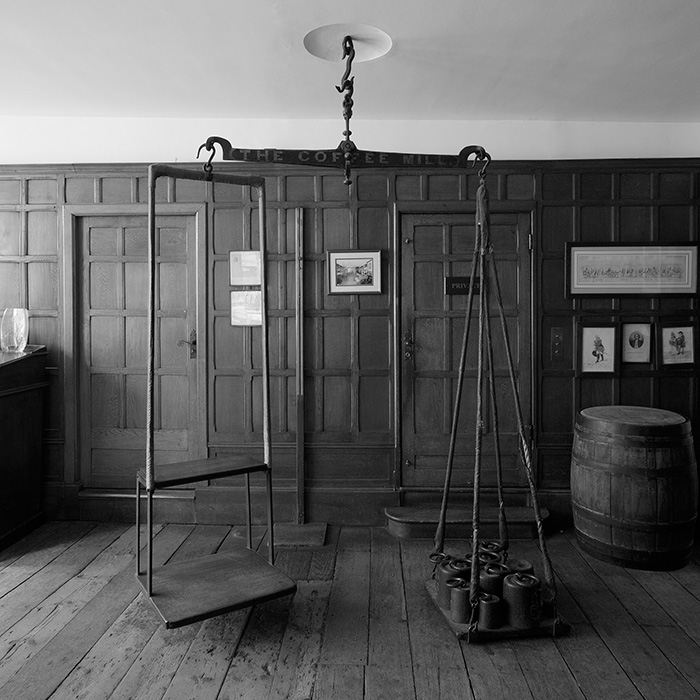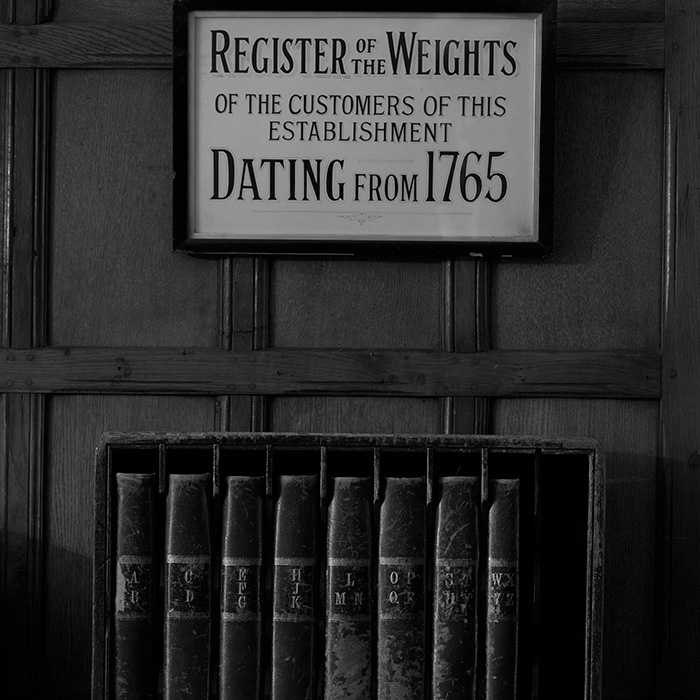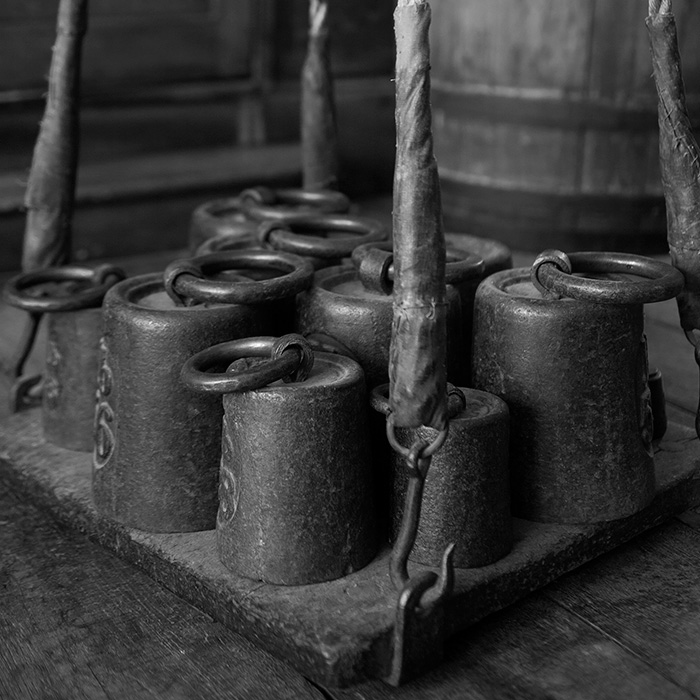History in the weighing
Author: Berry Bros. & Rudd

Photograph: Joakim Blockstrom
Although the old wooden floorboards of our shop have echoed for two and a half centuries to the comings and goings of princes, politicians, poets, sportsmen and other celebrities in many fields, the earliest entry in our Weight Books, the records of our famous scales, is 1765. It may have been the first George Berry’s grandfather, John Clarke, who promoted weighings at Number Three into a ceremony that became all the rage with fashionable St. James’s Street society, to the great benefit of his business, but in any event it has provided our firm with unique archives on a small, intimate corner of history.
The reality of such customers as William Pitt, Charles James Fox, Lord Byron, Tom Moore, a string of Regency wits and dandies, giants of the Victorian scene such as Lord Melbourne, is made flesh and blood because we know what they weighed. These records of our scales have been the pivot for the series of articles in lighter historical vein about the galaxy of people of whom we can say, ”They Came to Number Three”, and which on occasion has included groups such as the British Raj and the Bourbons. Moving backwards and forwards in history, we have written about Sir Robert Peel, Dame Nellie Melba, Charles Lamb, Rosa Lewis, Napoleon III among others – and still the barrel has scarcely been broached. Before we plunge into it again to discover the weighing secrets of yet another remarkable customer, we thought it appropriate in the 250th anniversary year of the building of our present premises to pause and look back at some old favourites, particularly where the scales at Number Three have played a special part.
Occasionally, our records have appeared to contradict accepted beliefs about a well-known personality, as in the case of Beau Brummell, subject of the very first issue of the magazine in 1954. It has generally been supposed that he never again crossed the Channel after he fled to France in 1816 to escape a debtor’s prison in England. And yet, on July 26, 1822, we recorded his weight at 10 stone 13, indicating a secret visit to London. In his book, In Search of Wine, Walter Berry suggested that Brummell returned to arrange publication of a treatise on ladies’ dress that legend has it he was reduced to writing at the time. If so, the risk was in vain because no such publication by George Brummell exists – although what a classic the Prince of the Dandies’ opinions on such a matter would have proved today!
He was weighed over 40 times at Number Three, always in “Boots”, sometimes in “Great Coat” as well, and averaging around 12 stone 8, so he would have been a very familiar figure to George Berry. Perhaps, remembering how Brummell’s patronage even in grandfather Clarke’s day had introduced a host of well-born customers to the shop, Mr. Berry was a creditor who had made it clear he would never press his claims, and who accorded his usual welcome to this fallen idol of society, thinned down by the privations of a sadly altered destiny. Brummell was a connoisseur who set the pace in appreciation of the good things of life, and the contents of his cellar, auctioned off along with other effects by Mr. Christie, included “10 dozen of capital Old Port, 16 dozen of Claret (Beauvais), Burgundy, Claret and Still Champagne – the whole of which have been nine years in bottle in the Cellar of the Proprietor”. The Beauvais Claret (whatever this might be) sold for £5 8s., the Champagne for £3 5s., and the Port for £4 the dozen.

Photograph: Joakim Blockstrom
At other times it has been the findings of our scales themselves that have briefly taken the centre of the stage, most memorably in the account by our old friend, the late James Bone, of how a judge in the famous Tichborne trials sought out the records at Number Three to discover the weights of the grandfather and father of the lost heir. Mr Bone had the tale from an eminent Boston lawyer, and it concerned Judge Bovill, who tried the first case in 1871-2.
The claimant, acknowledged by Lady Tichborne to be the son lost to her at sea in 1854, was really a Queensland butcher called Arthur Orton, who had deserted a sailing ship at Valparaiso in 1850. He brought an evictment action against the trustees of the Tichborne estates after other members of the family had produced evidence of his true identity. The notoriety of the case was given added zest because of the claimant’s size; he was “a man-mountain of enormous bulk, weighing over 24 stone, big-framed”. Lady Tichborne came of French stock and was not a large woman, and Judge Bovill, closeted at Number Three with the then senior partner, Henry Berry, learned that the claimant’s supposed grandfather, Sir Henry Tichborne, weighed 9 stone 11½ at the age of thirty-two, while the father, Sir James Francis Tichborne, turned the scales at 10 stone 8 when he was thirty-eight.
Then there was that tireless fact-seeker, Sir Francis Galton, Victorian gentleman and scientist, father of the theory of eugenics, who used our Weight Books as the basis for his paper, “The Weights of British Nobleman During the Last Three Generations”. He found that violent fluctuations in weight were more common in the earlier than in the later entries, and argued that this pointed to “an irregularity in the mode of life that was greater two or three generations back than now”. He deduced that “there can be no doubt that the dissolute life led by the upper classes about the beginning of the nineteenth century has left its mark on their age-weight traces…“.
The scales at Number Three had a special significance, too, for His Highness the Aga Khan, spiritual leader until his death in 1957 of ten million people, whose influence and legendary fortune so fascinated European columnists. Patron of the Turf, statesman and bon vivant, his records cover several pages of our books, for he was weighed over 300 times. His fight against corpulence had its pragmatic side, for according to Ismaili tradition, his weight at his jubilee had to be balanced by diamonds by diamonds by diamonds and other precious stones for distribution to the poor. Fortunately for his followers, the epicurean in this most life-loving of spiritual leaders proved stronger than the ascetic, and during the years between the 1920s and the outbreak of the last war, when he visited us most frequently, his weight rose from 16 stone 4 to well over 17 stone.
A much earlier famous Turf personality, Thomas Thornhill, born in 1780, had the distinction of being the heaviest man ever weighed at Number Three until 1950. His record of 23 stone 12½ was broken that year when a customer brought in an Irish wrestler; we managed to measure his 26 stone 7 bulk only by adding a young lady staff member to our stock of weights.
Nearly 150 years before the brawny Irishman outweighed Mr. Thornhill, the scales had registered the form of one of the most famous prizefighters of all time – Tom Cribb, champion of England, who twice beat off the transatlantic challenge from the formidable black American, Tom Molineaux. When he came to Number Three on July 23 1808, Cribb was still a rising star, having beaten the reigning champion, Jem Belcher, in his first big fight three months previously. A return match had been arranged between the two pugilists, which Belcher was confident he would win, and both protagonists arrived at our shop for what seems remarkably like an official weigh-in. The entry in our records shows Cribb at 14 stone 7 to Belcher’s 12 stone 1, and the signature of George Berry appears as witness to this momentous event, in which every young blood and follower of “the fancy” – to say nothing of Number Three’s illustrious customers, the Prince Regent and his brothers, the Royal Dukes – are likely to have taken an eager interest. The young wine merchant, just turned twenty-one, no doubt thoroughly enjoyed his role on this occasion; and perhaps he also engineered a holiday from his duties the following February to join “the nobs” at Epsom who watched Cribb beat Belcher for the second time.

Photograph: Joakim Blockstrom
According to a tradition at Number Three, it was one of the Royal Dukes who saved our scales from confiscation when they were about to be removed by an over-zealous official for failing to comply with Government regulations. The law required all such weighing apparatus to bear the Government stamp, but the old scales at Number Three refused to be impressed by authority. By that time it was George Berry’s name that figured outside the double-fronted shop built by William Pickering, and the proprietor was understandably dismayed by the prospect of losing such a treasured possession of the business. It was during this painful scene, so the story goes, that one of the Dukes (whose identity has never been pinpointed) arrived to check up on his weight. When it was explained to him that the equipment was being removed as a safeguard against fraud, His Royal Highness exclaimed: “Who dares to say that my old friend Berry is guilty of fraud? Leave those things here and let me be weighed. I will be responsible”.
The weights of the Duke of Clarence, Cambridge, Kent, Sussex and York are clearly noted for delvers into history’s odd corners to discover (the Duke of York was weighed nearly 60 times), and have been disclosed in past issues. But what of the Prince Regent, later King George IV, the heaviest and most self-conscious weight-watcher of all the Royal brothers, whose obesity, cruelly caricatured by James Gillray, daily drew tittering crowds to Mrs. Humphreys’ print shop down the road at No. 27 St. James’s Street?
Here, we confess, there is something of a mystery, but one that we have not despaired of resolving some day. According to newspaper cuttings of the 1920s in our possession, whose source is publications that have all now ceased to exist, “Prinny” was a frequent visitor to Number Three. Thus, from John O’London’s Weekly, May 19, 1923: “George, Prince of Wales was weighed many times at Berry’s and it is pointed out that all his records are entered in a hand which is believed to be his own”; and from The Weekly Dispatch, November 20, 1921: “An examination of Berry’s old weighing books showed. . . George IV at one time weighed as much as 17 stone, though there are entries marked ‘shoes after gout’ where he was a stone or two less”. Warner Allen, in his history of our firm, asserts that “if Prinny tried his weight it was in secret and incognito, and the results must have been anonymously inserted on the last page of the volume devoted to the Royal Dukes, which is virgin of all heading”. But with detailed extracts from our Weight Books, listed by The Morning Post in 1922, before us, showing dates and weights that could hardly have been manufactured out of thin air, conviction grows that George Berry kept close a Royal secret – private records of the Prince Regent’s weights. These records appear to have existed before the last war, and may yet be unearthed from our archives.
Sometimes readers have cast fresh light for us on famous characters who frequented Number Three. In the Spring of 1976, the magazine carried an article on George Cruikshank, eccentric early illustrator of Dickens, who in his fifties embraced the temperance movement after a none-too-sober youth and maturity. It was said of him then that “no man drank with more fervour and enjoyment, nor carried his liquor so kindly, so merrily”. Berry’s shop would have been well-known to him ever since the day when the young Mr. Cruikshank was invited (by the same Mrs. Humphreys of the print shop already referred to) to supply drawings in the Gillray manner for her front window. Following his conversion, the artist campaigned zealously in the cause of the temperance movement, and we may well have been the wine merchants outside those premises Cruikshank shook his fist and bawled, “Give me back my thousand pounds!”.
After we had depicted this former customer in his eighties leading a blameless, teetotal and rather dull existence with his second wife, it was an eye-opener indeed to receive from Mr. John Wardroper, then working on a biography of Cruikshank, a very different disclosure. Mr Wardroper wrote: “His will shows that he was maintaining a woman and ten children in a separate household not far from his home. He left her most of his property (to be invested in the Temperance Land and Building Society) and also ‘all such furniture, books, wines and household effects belonging to me as shall at the time of my death be in the said house’. So it seems he had been taking two pleasures on the sly all those years. . . ”. The scales on which all these and many other famous people sat to be weighed still occupy their usual place in our shop, below the great, 17th-century beam that hangs beneath the ceiling and bears the golden legend, “The Coffee Mill”. For many of Number Three’s present-day customers and for our staff, carrying out the traditional services of the firm, they are a kind of time-machine, vividly connecting our old premises with outstanding names of long ago.
For the chance to win your weight in wine, simply purchase an unmixed case from our Own Selection range by 30th April. Find out more about the competition, including terms and conditions, here.


